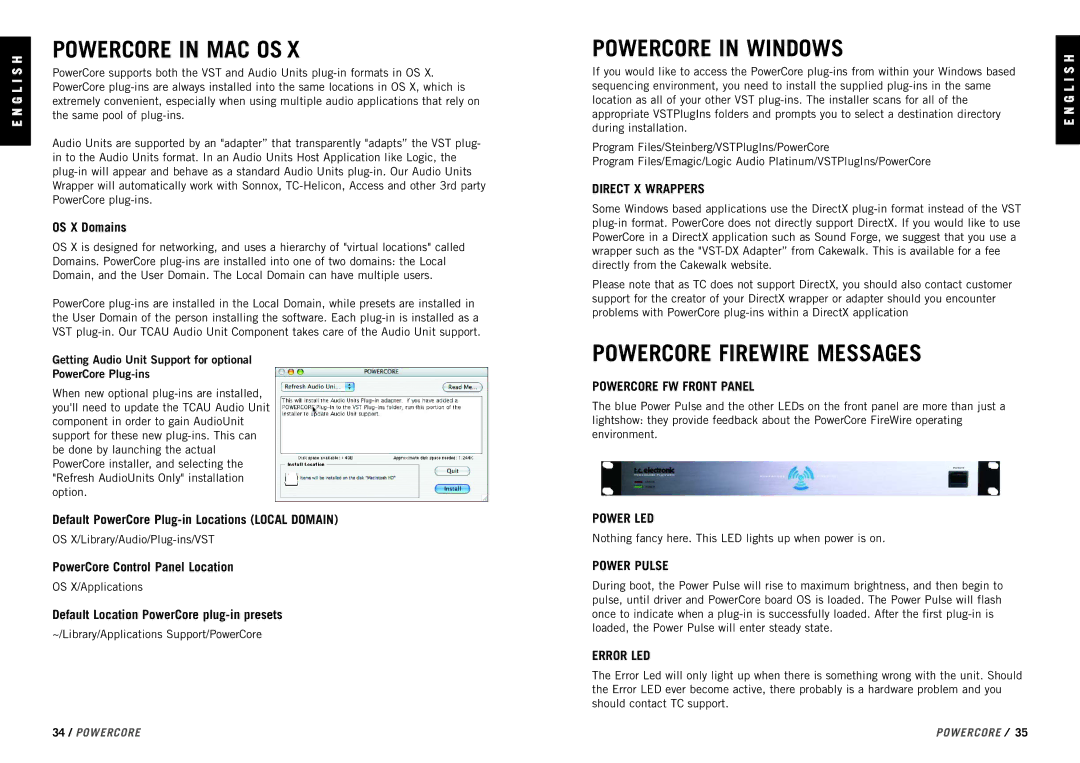POWERCORE IN MAC OS X
PowerCore supports both the VST and Audio Units plug-in formats in OS X. PowerCore plug-ins are always installed into the same locations in OS X, which is extremely convenient, especially when using multiple audio applications that rely on the same pool of plug-ins.
Audio Units are supported by an "adapter” that transparently "adapts” the VST plug- in to the Audio Units format. In an Audio Units Host Application like Logic, the plug-in will appear and behave as a standard Audio Units plug-in. Our Audio Units Wrapper will automatically work with Sonnox, TC-Helicon, Access and other 3rd party PowerCore plug-ins.
OS X Domains
OS X is designed for networking, and uses a hierarchy of "virtual locations" called Domains. PowerCore plug-ins are installed into one of two domains: the Local Domain, and the User Domain. The Local Domain can have multiple users.
PowerCore plug-ins are installed in the Local Domain, while presets are installed in the User Domain of the person installing the software. Each plug-in is installed as a VST plug-in. Our TCAU Audio Unit Component takes care of the Audio Unit support.
Getting Audio Unit Support for optional
PowerCore Plug-ins
When new optional plug-ins are installed, you'll need to update the TCAU Audio Unit component in order to gain AudioUnit support for these new plug-ins. This can be done by launching the actual PowerCore installer, and selecting the "Refresh AudioUnits Only" installation option.
Default PowerCore Plug-in Locations (LOCAL DOMAIN)
OS X/Library/Audio/Plug-ins/VST
PowerCore Control Panel Location
OS X/Applications
Default Location PowerCore plug-in presets
~/Library/Applications Support/PowerCore
POWERCORE IN WINDOWS
If you would like to access the PowerCore plug-ins from within your Windows based sequencing environment, you need to install the supplied plug-ins in the same location as all of your other VST plug-ins. The installer scans for all of the appropriate VSTPlugIns folders and prompts you to select a destination directory during installation.
Program Files/Steinberg/VSTPlugIns/PowerCore
Program Files/Emagic/Logic Audio Platinum/VSTPlugIns/PowerCore
DIRECT X WRAPPERS
Some Windows based applications use the DirectX plug-in format instead of the VST plug-in format. PowerCore does not directly support DirectX. If you would like to use PowerCore in a DirectX application such as Sound Forge, we suggest that you use a wrapper such as the "VST-DX Adapter” from Cakewalk. This is available for a fee directly from the Cakewalk website.
Please note that as TC does not support DirectX, you should also contact customer support for the creator of your DirectX wrapper or adapter should you encounter problems with PowerCore plug-ins within a DirectX application
POWERCORE FIREWIRE MESSAGES
POWERCORE FW FRONT PANEL
The blue Power Pulse and the other LEDs on the front panel are more than just a lightshow: they provide feedback about the PowerCore FireWire operating environment.
POWER LED
Nothing fancy here. This LED lights up when power is on.
POWER PULSE
During boot, the Power Pulse will rise to maximum brightness, and then begin to pulse, until driver and PowerCore board OS is loaded. The Power Pulse will flash once to indicate when a plug-in is successfully loaded. After the first plug-in is loaded, the Power Pulse will enter steady state.
ERROR LED
The Error Led will only light up when there is something wrong with the unit. Should the Error LED ever become active, there probably is a hardware problem and you should contact TC support.

